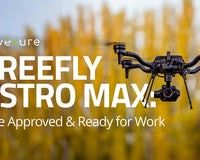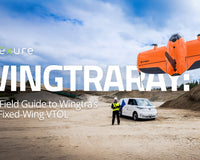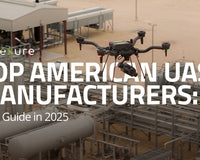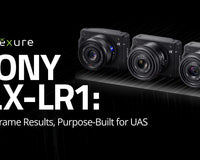The drone LiDAR market is crowded. Between compact payloads for environmental monitoring and high-end systems used in large-scale corridor mapping, there’s no shortage of options. But for many professionals, the real challenge isn’t finding a sensor that can collect data. It's finding one that actually fits the job.
Some systems are overbuilt, adding unnecessary weight or complexity for applications that don’t require it. Others lock users into proprietary drone platforms or software, limiting flexibility across teams or projects.
And then there are the budget-friendly options that sound good on paper but fall short on accuracy, point density, or support when it counts.
GeoCue’s latest sensors, the TrueView 1 (TV1) and TrueView 1 Lite (TV1 Lite), are designed to fill a middle ground. They offer survey-grade performance in lightweight, flexible packages with native compatibility across a wide range of drone platforms.
Each system is built and supported in the U.S., backed by software, training, and technical support that make adoption easier for both new and experienced LiDAR users.
In this guide, we’ll break down what makes the TV1 and TV1 Lite stand out, how they differ, and whether one of them might be a good fit for your workflow.
Who is GeoCue?

Founded in 2003 and based in Huntsville, Alabama, GeoCue develops hardware, software, and service solutions for LiDAR and drone mapping professionals. Their offerings span the full data lifecycle, from acquisition to post-processing, and are backed by in-house training, technical support, and consulting services.
In 2009, GeoCue acquired QCoherent, the original developers of LP360. What began as a tool for managing manned-aircraft LiDAR data has since evolved into a versatile software platform that now includes LP360 Drone and LP360 Geospatial. These tools are at the core of GeoCue’s sensor and software ecosystem, offering users powerful capabilities for point cloud management, photogrammetric processing, and quality control.
While we’ll take a closer look at LP360 later in this post, it’s worth noting that GeoCue’s integration of hardware, software, and training is designed to simplify adoption for professionals who need dependable tools without unnecessary complexity.
TrueView 1 vs. TrueView 1 Lite: Key Differences

Both the TrueView 1 (TV1) and TrueView 1 Lite (TV1 Lite) are built around the same core LiDAR engine—a Hesai XT-32M2X dual-return scanner capable of 640,000 points per second. They’re also equal in weight at just 1.4 kg, and both are natively compatible with a wide range of drone platforms. But there are some important differences worth noting.
Camera Configuration
-
TV1 Lite includes a built-in 5 MP FLIR global shutter camera with an 80° field of view. It’s compact, lightweight, and ideal for LiDAR-first missions where high-res photogrammetry isn’t required.
-
TV1 offers configurable mapping cameras in 26 MP, 45 MP, or 61 MP resolutions. These higher-end optics are better suited for workflows that demand colorized point clouds, feature extraction, or detailed photogrammetric models.
Trajectory Correction Options
-
TV1 Lite uses a traditional Single Base PPK workflow, which requires a base station to be set up in the field.
-
TV1 supports both Single Base and No Base Station options, the latter allowing users to post-process trajectories via a virtual correction service. This can streamline field deployment, particularly for multi-site or remote operations.
Software & Licensing
-
TV1 Lite includes one year of point cloud processing and the ability to generate colorized, georeferenced LAS files. Access to LP360 Drone’s full suite of features requires additional licensing or upgrades.
-
TV1 includes a full one-year license of LP360 Drone, enabling:
-
Multi-cycle SLAM/PPK/RTK processing
-
Precision point cloud editing and QA/QC tools
-
Fast, high-quality colorization
-
2D, 3D, and immersive point cloud visualization
-
Project size support up to 10 km²
Platform Compatibility
Both sensors are available with mounting options for major drone platforms including:
-
DJI Matrice 300/350
-
Freefly Astro
-
Freefly Alta X
-
Inspired Flight IF800 and IF1200
TrueView 1 vs. TrueView 1 Lite Comparison
|
Feature |
TrueView 1 (TV1) |
TrueView 1 Lite (TV1 Lite) |
|
LiDAR Scanner Type |
Hesai XT-32M2X (Dual Return) |
Hesai XT-32M2X (Dual Return) |
|
Point Rate |
640,000 pts/sec (single return) |
640,000 pts/sec (single return) |
|
Returns |
Dual return |
Dual return |
|
Camera Option |
Choice of 26 MP, 45 MP, or 61 MP Global Shutter Mapping Camera |
Fixed 5 MP FLIR Global Shutter Camera with 80° FOV |
|
Shutter Type |
Global shutter |
Global shutter |
|
Weight |
1.4 kg |
1.4 kg |
|
Software & Licensing |
Includes full 1-year LP360 Drone license with full processing, editing, and QC tools |
Includes 1-year point cloud processing; LP360 add-ons sold separately |
|
Available Drone Mounts |
DJI M300/350, Freefly Astro, Alta X, IF800, IF1200, and more |
DJI M300/350, Freefly Astro, Alta X, IF800, IF1200, and more |
|
Starting Price |
~$34,000 (varies by camera and mount) |
~$22,000 (varies by mount and options) |
Inside LP360 Drone: A Powerful Geospatial Workflow Engine

For teams investing in a drone LiDAR solution like the TrueView 1, software is half the equation. LP360 Drone is the engine that powers post-processing, QA/QC, visualization, and deliverable generation—and it’s what sets the TrueView ecosystem apart for many users.
Originally designed for manned aircraft LiDAR, LP360 has evolved into a full-featured desktop solution for UAV-based survey workflows. The platform supports both LiDAR and photogrammetric data, with an emphasis on repeatable workflows, precision QA tools, and flexible visualization environments.
Built for LiDAR and Imagery Workflows
LP360 Drone is more than just a LAS viewer. It enables a complete geospatial workflow from raw trajectory data and point cloud cleanup through to finished products like contour maps, breaklines, terrain models, and volumetrics.
Key capabilities include:
-
Multi-flight import and batch processing
-
Synchronized 2D, 3D, profile, and immersive viewers
-
Automated and manual classification tools
-
Volume calculation tools with auto base detection
-
Advanced feature editing in 3D
-
DEM/DTM generation and export to CAD environments
Its support for LAS, trajectory, and image files allows data from DJI, Microdrones, TrueView, YellowScan, Phoenix LiDAR, and other systems to be processed seamlessly within a consistent environment.
Intuitive GIS Interface with Customizable Workflows
The latest GUI update introduces:
-
Ribbon-style toolbars organized by function
-
A custom tab builder for personalized workflows
-
A Quick Access Toolbar for commonly used tools
-
Real-time help and support access
Precision Tools for Quality Control
Professionals can:
-
Detect and correct geometric misalignments using Strip Align
-
Perform AI-powered ground classification
-
Verify point cloud accuracy using Image Explorer
-
Run precision surface reports and correction tools
-
Filter and edit based on class, return, intensity, and elevation
Platform Compatibility and Mounting Options

Both the TrueView 1 and TrueView 1 Lite are designed with flexibility in mind, offering native integration with a wide range of commercial drone platforms. Whether you’re flying mid-sized quadcopters like the Freefly Astro or heavy-lift systems like the Freefly Alta X or IF1200, GeoCue provides dedicated mounting options to get either system airborne with minimal friction.
Drone Platform Compatibility
|
Drone Platform |
TV1 |
TV1 Lite |
Mount Cost |
|
Inspired Flight IF800 |
✔️ |
✔️ |
$515 |
|
Freefly Astro |
✔️ |
✔️ |
$515 |
|
DJI Matrice 300/350 |
✔️ |
✔️ |
$515 |
|
WISPR SkyScout |
✔️ |
— |
$515 |
|
Inspired Flight IF1200 |
✔️ |
✔️ |
$1,650 |
|
SkyFront Perimeter 8 |
✔️ |
✔️ |
$1,650 |
|
Freefly Alta X |
✔️ |
✔️ |
$1,650 |
|
Harris Aerial H6 |
✔️ |
✔️ |
$1,650 |
|
Clogworks |
✔️ |
✔️ |
$1,650 |
Startup Costs: What to Expect
The TrueView 1 and TrueView 1 Lite are both positioned as accessible entry points into drone-based LiDAR, offering strong performance without the sticker shock of higher-end systems.
TV1 Lite Pricing
The TV1 Lite starts at approximately $22,000, with final pricing dependent on the selected drone mount and any optional software upgrades.
TV1 Pricing
The TrueView 1 starts at around $34,000, with cost scaling based on your choice of mapping camera, drone platform, and software options.
ROI Considerations
For many commercial operators, a single corridor project, stockpile inventory, or vegetation encroachment survey can offset a major portion of the equipment cost. Unlike platform-locked systems, the TrueView sensors work across multiple aircraft and are not tied to proprietary software ecosystems.
Frequently Asked Questions: TrueView 1 and TrueView 1 Lite
1. What’s the biggest difference between the TV1 and TV1 Lite?
The main differences are the mapping camera options and software licensing. TV1 supports higher-resolution cameras (26 MP, 45 MP, or 61 MP) and includes a full LP360 Drone license. TV1 Lite uses a fixed 5 MP camera and comes with basic point cloud processing tools, with LP360 upgrades available separately.
2. Are both sensors survey-grade?
Yes. Both the TV1 and TV1 Lite use the same Hesai XT-32 dual-return scanner and are capable of producing survey-grade results when flown and processed correctly.
3. Do I need a base station in the field?
TV1 Lite requires a base station for PPK processing. TV1 supports both base station workflows and a no-base option using virtual correction services during post-processing.
4. Can I fly these sensors on more than one drone?
Yes. GeoCue offers mounting kits for a variety of platforms. If you operate multiple compatible drones, you can purchase additional mounts and transfer the sensor between aircraft as needed.
5. What’s included with the purchase?
Each system includes:
-
The LiDAR sensor and integrated camera
-
One year of software (full LP360 Drone for TV1; basic processing tools for TV1 Lite)
-
One year of hardware/software support
-
A two-day, in-person training course at GeoCue HQ in Huntsville, AL
6. What platforms are supported?
Both models support DJI M300/M350, Freefly Astro, Freefly Alta X, Inspired Flight IF800 and IF1200, SkyFront Perimeter 8, Harris Aerial H6, and Clogworks. TV1 also supports WISPR SkyScout.
7. Is LP360 required to use these sensors?
LP360 is not strictly required, but it’s strongly recommended. It’s the native post-processing environment for both sensors, and many of GeoCue’s automation and QA tools are only available through LP360 Drone.
8. How much does LP360 Drone cost if I need to renew it after the first year?
As of this writing, LP360 Drone is priced at $1,625/year. Add-ons like Strip Align, AI Ground Classification, or Cloud Collaborate are available separately.
9. How large of a project can I process?
The included LP360 Drone license with the TV1 supports projects up to 10 km². If you require larger coverage areas, an upgrade to the Unlimited version is available.
10. Can I finance or lease these sensors?
Yes. Many enterprise clients choose to lease or finance their drone LiDAR system through third-party equipment finance firms. Advexure’s sales team can help facilitate those discussions if needed.
Choosing the Right Tool for the Job
The TrueView 1 and TV1 Lite offer hard-to-find flexibility and performance without platform or software lock-in.
Whether you’re a surveyor building high-resolution terrain models, a VDC team tracking stockpiles on active job sites, or a utility contractor scanning ROWs for vegetation encroachment, both systems offer a viable path into LiDAR without overspending or overcomplicating your workflow.
In the end, whether the TV1 or TV1 Lite is the better fit depends entirely on your platform, deliverables, and budget. Both options are capable. What matters is which one aligns best with the work you’re doing and the way your team operates.
If you’re evaluating either sensor or need help choosing the right configuration, Advexure’s team of Part 107 pilots and subject matter experts is here to help. With more than a decade of experience integrating drones, sensors, and software into real-world operations, we’ll help you find the best-fit solution for your goals. Request a quote today!










